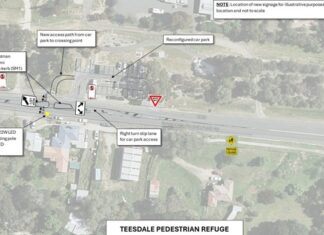By NOEL MURPHY
A RARE orange-bellied parrot has been sighted near Anglesea after being released to the wild in Tasmania late last year.
The first captive-bred example of its species seen on the mainland this year was spotted on 29 April and 2 and 7 May, said Save the Orange-Bellied Parrot campaigner Debbie Lustig.
Dubbed ‘Blue L Silver’, the three-year-old female’s arrival in Victoria after a 580km journey up the west coast of Tasmania over King Island and across Bass Strait gave “fresh hope for the survival of the beleaguered species”, Ms Lustig said.
Orange-bellied parrots number just 70 in the wild, with another 330 in a captive-breeding program.
“Blue L Silver has proven herself hard-wired to migrate between Tasmania and the mainland despite being raised in a cage and being descended from birds that have been in captivity for five generations,” Ms Lustig said.
“The rare female parrot hatched at Taroona government breeding facility (in Hobart) in the summer of 2011/2012 and was fitted with leg bands Blue L (left leg) and silver (right leg). She went on to produce three chicks in 2012/2013.
“In November 2013 she was released to the wilderness of Melaleuca, Tasmania, as one of the 24 birds of the first captive-bred release since 2008. She also bred there, producing an impressive five chicks.”
Ms Lustig said the parrot had been observed feeding on a plant never previously recorded as a food for orange-bellied parrots – seaberry saltbush.
The endangered parrot became a political issue several times in the past when its presence conflicted with developments including a petrochemical complex proposed for Point Lillias and a $220 million wind farm at Bald Hills in Victoria south-east.
In recent months a No TasWind Farm Group has argued a $2 billion wind farm proposed for King Island would threaten the parrot.






